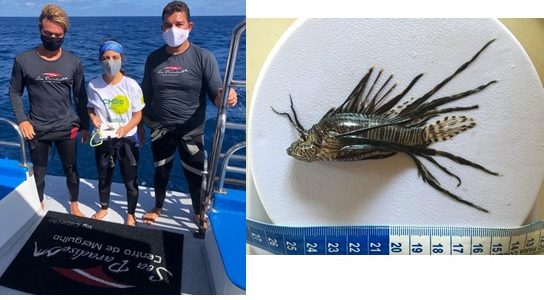PELD ILOC long term monitoring on Brazilian oceanic islands had new occurrences of lionfish
2021, September
A second lion fish captured at 25 meters deep reefs of Fernando de Noronha oceanic island in Brazil in the last August.
PELD ILOC is a project that is part of the Brazilian long-term ecological program since 2012, and focuses on monitoring reef communities in the four Brazilian oceanic islands (Archipelagos of São Pedro and São Paulo, Fernando de Noronha, Trindade and Martin Vaz and Rocas Atoll – https://peldiloc.sites.ufsc.br/). After two years of field activities suspended due to the covid-19 pandemic, our team now fully vaccinated, and following the protocols established by the WHO in combating and preventing the new coronavirus, will continue the monitoring activities in next October. However, after 5 specimens of lionfish had been captured at Fernando de Noronha, the lionfish is now a new focus on monitoring protocols.
The lionfish (Pterois spp.) have dramatically expanded their distribution range to an area encompassing the eastern coast of the USA, Bermuda, the entire Caribbean region and the Gulf of Mexico in less than 30 years. The lionfish have characteristics that give it a great invasive success, such as its broad dietary breadth, predation efficiency, high fecundity, fast growth, resistance to parasites, mesophotic habitat range and lack of predators. However, the Amazon Barrier, a biogeographical break resulting from the freshwater and sediment discharge of the Amazon and Orinoco Rivers, and contrary currents, imposed resistance to the arrival and establishment of the species in Brazilian waters, at least until now (Luiz et al., 2003).
The first of several records in the same year of lionfish in Brazilian waters was carried out in mesophotic reefs at the mouth of the Amazon River, as well as in the Fernando de Noronha Archipelago. These records allowed researchers to infer an invasion route into the South Atlantic, as can be read in the article “Multiple lionfish (Pterois spp.) new occurrences along the Brazilian coast confirms the invasion pathway into the Southwestern Atlantic”, published last May, in ”Biological Invasions” by Luiz and co-authors (Luiz et al., 2021). Since then, another four individuals of lionfish have been collected in less than a month in Fernando de Noronha. As those oceanic islands hold many endemic species, with short range distribution, which are potential prey to lionfish, monitoring and catch control will be since now implementing. The lionfish monitoring activities, as well as the partnership and training of ICMBio staff (local environment agency) are being carried out by the Long-Term Ecological Program (from the Portuguese acronym, PELD) in Fernando de Noronha, and then in the other oceanic islands.
